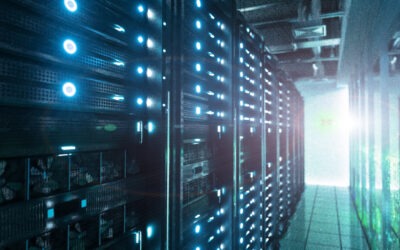Despite all the progress made with immersion cooling since the technique was first used in the 1960s, dunking your expensive hardware into liquid still sounds counterintuitive. Why would anyone go to the effort of submersing their servers to cool them? The answer is that the efficiency of immersion makes it the future of cooling.
Why would you put servers into liquid?
First things first – and excuse us for stating the obvious – the fluid in question is not water. That would have been a very short-lived experiment for all involved. Immersion cooling involves submerging hardware (servers, GPUs, CPUs, etc.) in special dielectric liquids (such as mineral oil) that conduct heat but not electricity. The details of how the cooling happens vary depending on whether it’s a single-phase or two-phase immersion cooling system:
- Single-phase: The coolant remains in liquid form and is pumped to a heat exchanger where the heat is transferred to a cool water-circuit. The cooling baths are open-topped as there’s little risk of the coolant evaporating.
- Two-phase: This system uses a different kind of dielectric liquid, which does change state when it meets enough heat. In this case the heat coming from the hardware causes a portion of the dielectric liquid to boil and change to gas. The gas rises, meets a condenser and ‘rains’ back into the pool, cooling the working fluid again. In this instance the baths need to be closed, otherwise the gas escapes before it can do its job.
In either case, the result is that the immersion liquid keeps the temperature of the hardware down in a highly effective, very energy efficient manner.
Why is immersion cooling so efficient?
Let’s compare immersion cooling with direct air cooling. Liquid is a more efficient conductor of heat than air is. And for air cooling to be effective, it needs to be both cooled and then blown directly at the heat source. This consumes a lot of energy, meaning you have to consider a) cost and b) environmental impact.
On the other hand, one cubic foot of mineral oil – a dielectric liquid used for immersion cooling – cools as effectively as 1200 cubic feet of air, and requires significantly less energy input. There are no fans involved, so instantly power use drops dramatically, which has a significant impact on ongoing costs.
It’s important to note at this point that there are other means of cooling that are also efficient – like the adiabatic cooling process that is in general use at our data centre. The advantages of immersion cooling really come into their own when we’re talking about high-power-density applications like HPC.
Is immersion cooling suitable for any application?
The more processing power a server has, and the more power it consumes, the more worthwhile it is to consider immersion cooling. For example, if you’re looking at power densities above 15 kW per rack, and/or you want to increase energy efficiency, immersion cooling is a proven solution that will provide both effective cooling – ensuring your machines perform optimally – and lower costs.
Bear in mind: Adaptations will be necessary to make the hardware suitable for immersion cooling. Because you no longer need the fans, you need to remove or disable all the components that are used for powering and moving air. Some other modifications may also be necessary depending on the server, such as sealing the hard drives (not applicable to SSDs or sealed helium-filled drives).
Where is immersion cooling available?
Immersion cooling hasn’t yet been widely adopted by commercial enterprises, so availability is somewhat limited. But with new technologies becoming available all the time, this is set to change. At Redcentric we are happy to be leading the way by making immersion cooling available to companies without cooling infrastructure.
We can host immersion cooling units for clients, which are integrated into our existing cooling system. This immersion cooling solution is a self-contained ‘pod’, making it easy to integrate with our existing data centre infrastructure without huge upheaval. One such client is PeaSoup, who is hosting their Eco-Cloud with Redcentric, also helping offer services cooled by immersion to more people. We provide the pipework for the water-cooled element and the water used to cool the immersion unit is chilled by our award-winning adiabatic cooling towers, resulting in incredible energy efficiency. This is a new and exciting development that makes immersion cooling more accessible to organisations that are keen to enhance their green credentials while managing the needs of their energy-intensive hardware.
If you’re interested in learning how working with a leading managed service provider could boost the energy-efficiency of your IT (even without going as extreme as immersion cooling), get in touch to get advice from one of our experts.

